One of the biggest attractions in Sicily is the town of Siracusa and its historic center – Ortigia Island (spelled both Ortygia and Ortigia). Of all the towns we visited in Sicily, I loved Siracusa the best. It’s one of the most fascinating places I have ever seen. “The biggest and most beautiful Greek city” – as Cicero described it.
This 2,700 year old Sicilian town still bears witness to the art and culture that have flourished in it throughout the centuries.
Unlike Palermo which is a complicated labyrinth of big streets and narrow alleys, Ortigia Island is relatively small and easy to visit. You can split your visit to Siracuse, Sicily, into two parts: one day for exploring Ortigia Island, and one day for visiting the Archaeological Park of Néapolis.
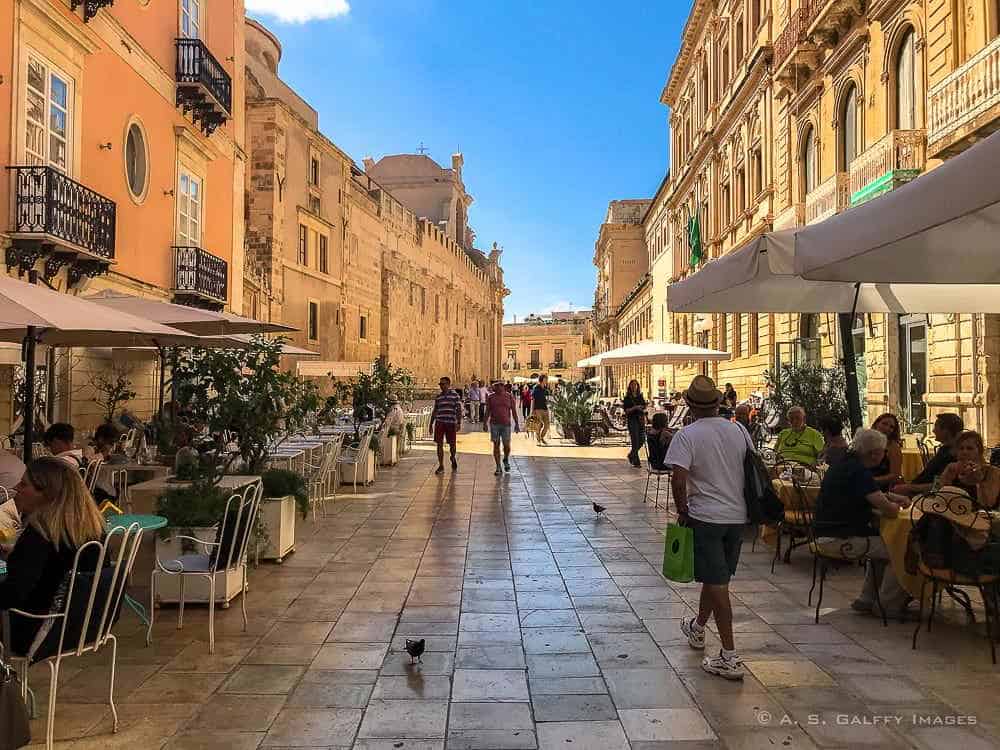
Table of Contents
A Brief History of Siracusa and Ortigia Island
Siracusa (or Syracuse) was built on Ortigia Island which is located near the southeastern corner of Sicily. Ortigia was the site of an ancient Greek settlement founded by the Corinthians in 734 B.C.
In its greatest period of economic prosperity and military power, Siracusa had a population of 300,000. The city was home to many ancient Greek personalities, including Archimedes – the most famous mathematician and inventor of all times.
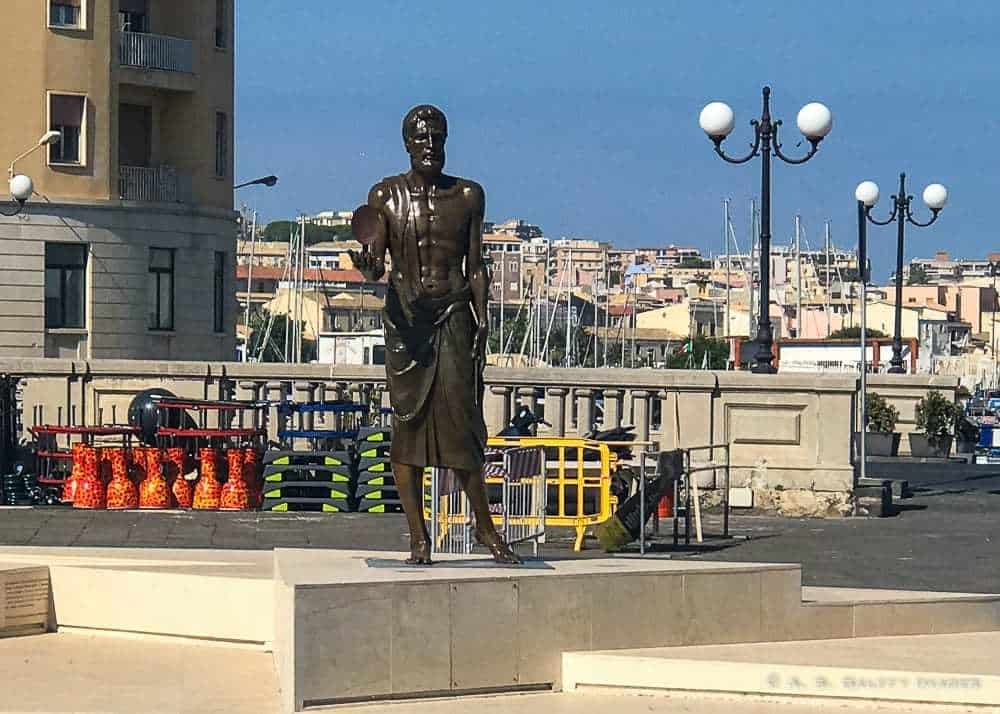
Throughout its history, Siracusa fell to the Romans, the Vandals, the Goths, the Arabs, the Normans, and to the Byzantines. The city also played an important role in the spreading of Judaism and Christianity in the central Mediterranean and then through the Italian peninsula.
Physical evidence of all these cultures are still visible today when looking at the city’s ancient structures and medieval treasures.
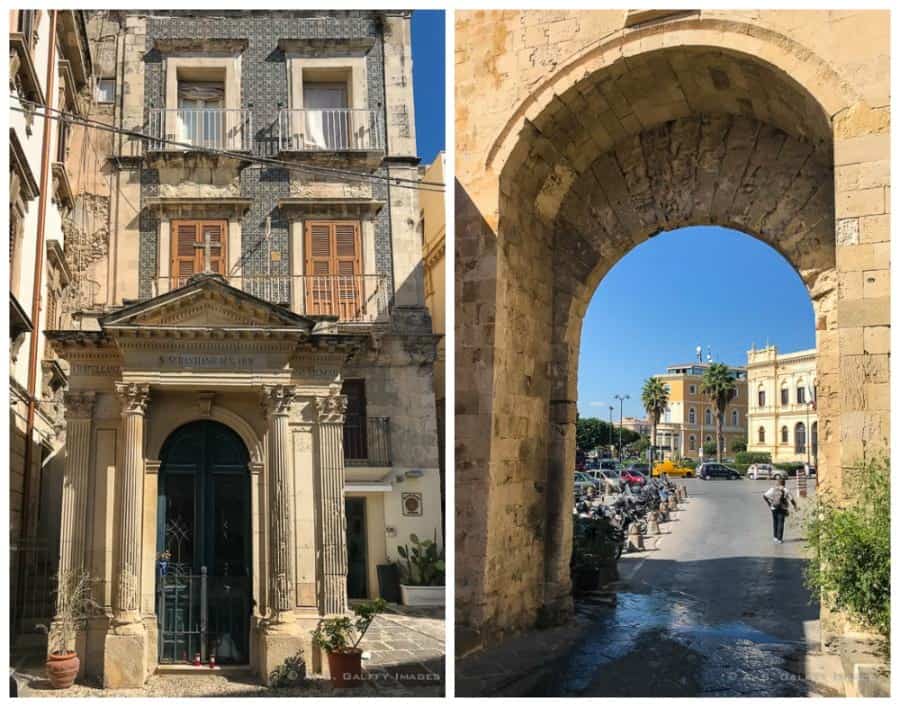
Visiting Ortigia Island– the Heart of Siracusa, Sicily
Also known as Città Vecchia, the small island of Ortigia (or Ortygia, in English) is the oldest part of the beautiful city of Siracusa, Sicily. The name “Ortigia” derives from the Ancient Greek ortyx, which means “quail.” The best way to see Ortigia is just to wander around.
The island is fairly small (about 1km long and 600 meters wide), so you can’t loose your way here. To reach Ortigia you have to cross one of the three bridges that connect it to the mainland.
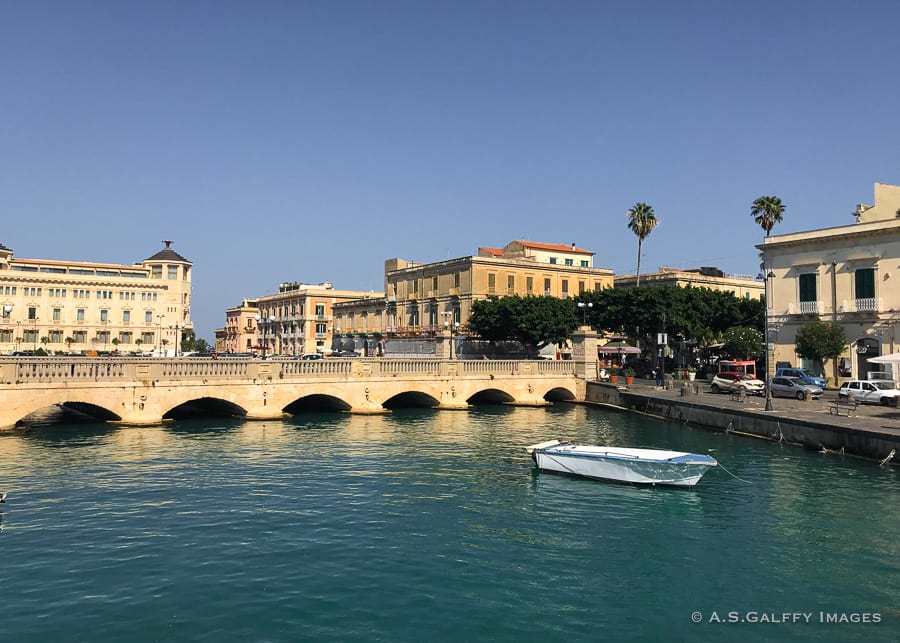
The old town of Ortigia is a labyrinth of charming ancient and medieval streets packed with over 2,500 years of history. It’s a paradise of sightseeing, dining and shopping, but also a great place to discover the history of Sicily.
Attractions on Ortigia Island
1. The Temple of Apollo
Right as you enter into Ortigia, you’ll come across the remains of the Temple of Apollo, dating back to the 6th Century B.C. The temple was supposedly the first great Doric temple of its kind in Sicily.
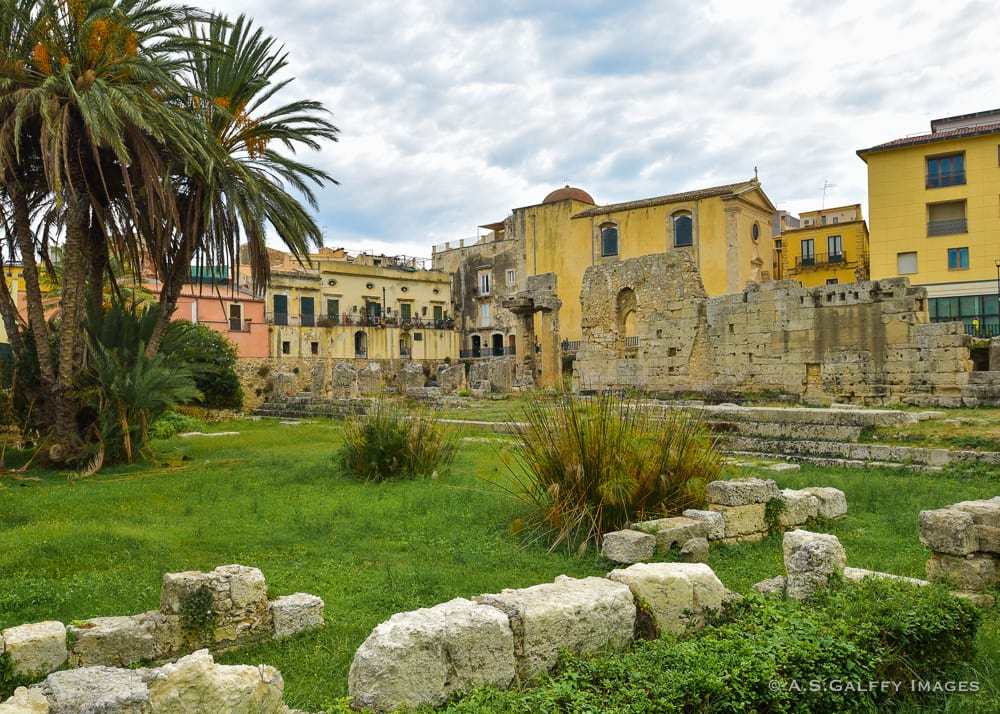
Throughout the centuries the temple underwent several transformations: from a Byzantine church to an Islamic mosque.
2. Piazza Archimede and the Fountain of Diana
Piazza Archimede was built in 1878 to honor the famous mathematician Archimede, who was killed by the Romans in 212 B.C., during the siege of Siracusa. Archimede’s tomb is located in the Archaeological Park on the mainland.
At the center of the Piazza is the beautiful Fountain of Diana, the Roman goddess. The fountain pretty much marks the center of Ortigia as well.
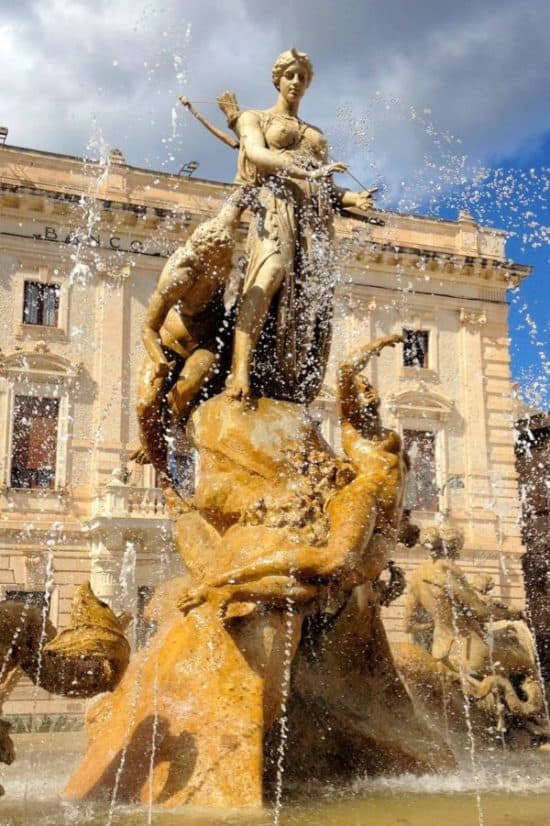
3. Piazza Duomo and the Cathedral of Siracusa
The highlight of Ortigia is the marvelous Piazza Duomo, that dates back to the 5th century B.C. As you stroll through the labyrinth of narrow ancient streets, you suddenly find yourself in this large square dominated by the Cathedral of Siracusa.
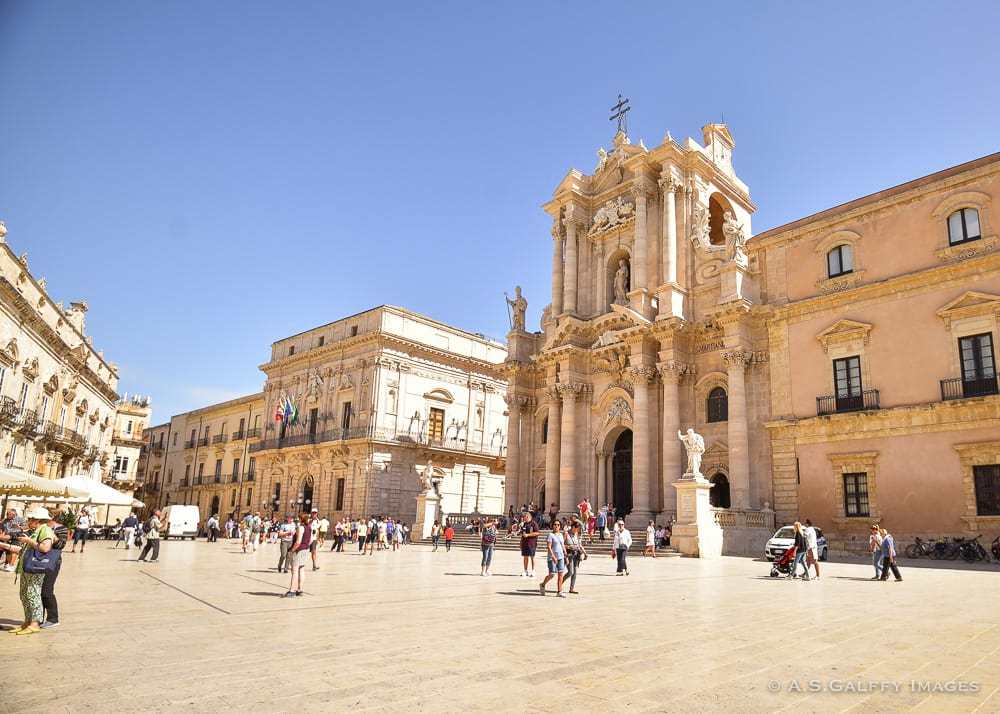
The Cathedral was actually built around the ancient Temple of Athena. You can still see the ancient Doric columns of the Greek temple in the wall of today’s cathedral.
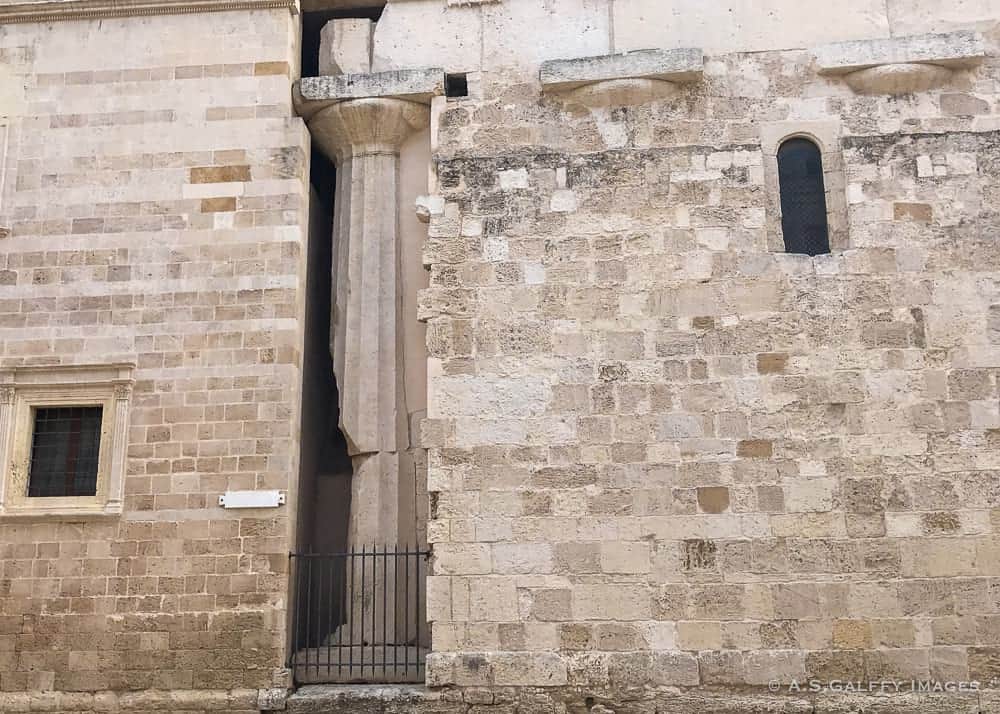
4. The Fountain of Arethusa
One of the most beloved attractions in Ortigia, Sicily, is the Fountain of Arethusa. The fountain became a symbol of the city as its fresh water saved the city’s population during several sieges.
The water of the Arethusa Fountain is actually coming from the Ciane river that crosses the Porto Grande (main port) under an impermeable layer of clay.
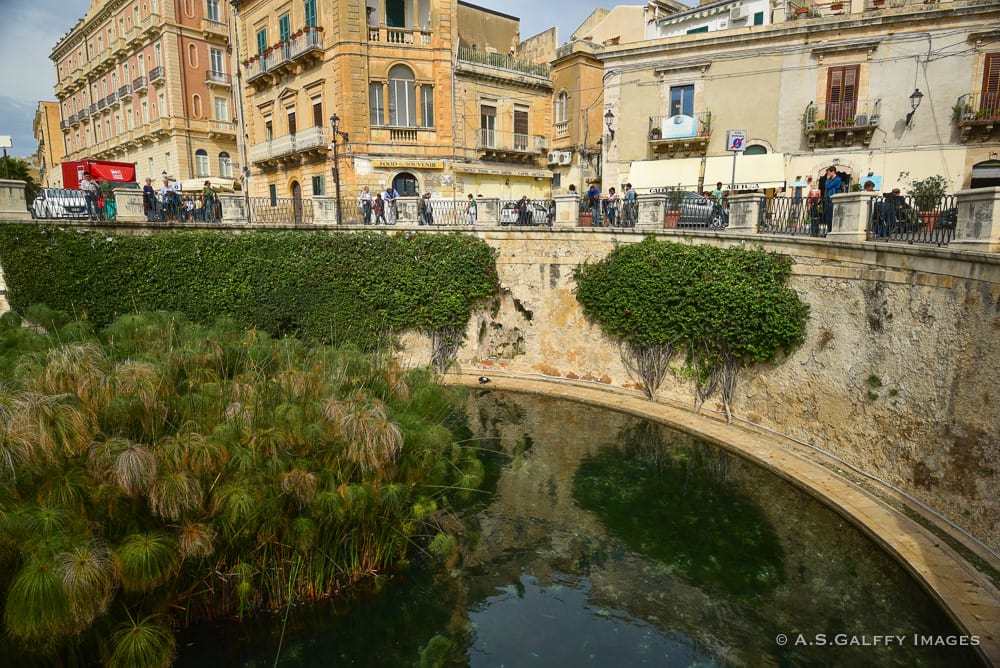
Legend has it that Arethusa, an Arcadian nymph, fled to Ortigia trying to escape the insisting courting of the river god Alpheios. Desperate to escape his advances, Arethusa asked the goddess Artemis for help.
Artemis took pity on the nymph and turned her into a spring, allowing her to escape underground. But Zeus moved by the pain of Alpheios turned him into a river. Alpheios located his prey and mixed his own waters with hers. They say that the spring connects directly under the sea to the river, at the sanctuary of Olympia.
One interesting thing about the Fountain of Arethusa is the papyrus plant growing inside. It seems that the only other place in the world where papyrus grows is on the banks of the Nile, in Egypt. 3000-4000 years ago, the Egyptian scribes were using the papyrus reeds for writing their records.
5. The Jewish Ritual Baths (Mikveh)
Another interesting site on Ortigia Island is the Jewish Mikveh (Jewish ritual baths). The Mikveh lies 30 feet (9 m) below ground under the Residenza Alla Giudecca Hotel. This part of town was once the Jewish quarter (the Giudecca). Mikvehs were used for certain Jewish religious rituals that required purification.
The Jews believed they can only be purified if they immerse themselves in ‘living water’ (water that flows naturally). The purpose of immersion in the Mikveh was not for physical cleansing, but rather for spiritual purity or renewal.
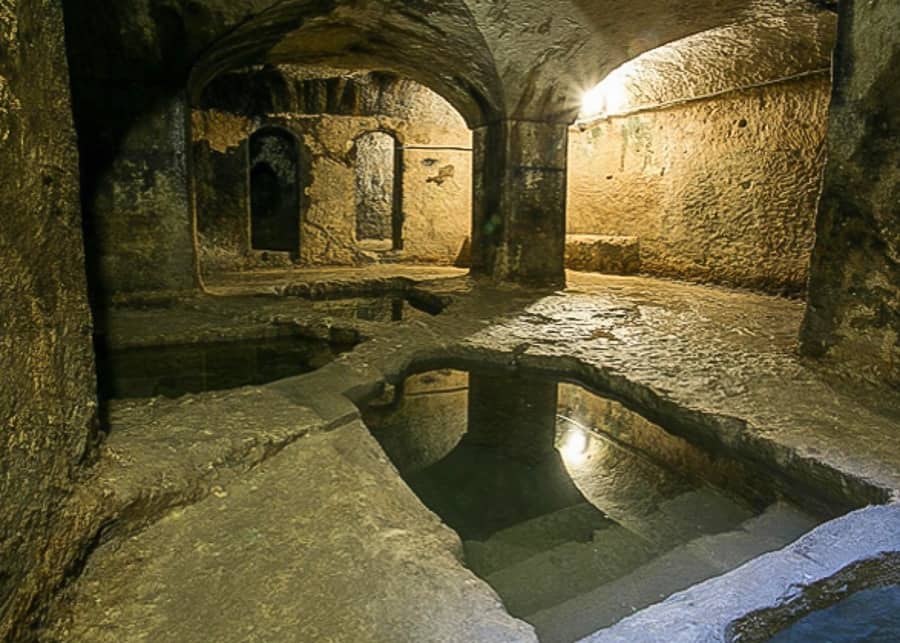
A freshwater spring flows underneath Ortigia, making it an ideal location to build a Mikveh. It is possible that the same underground spring feeds the Fountain of Arethusa.
The Mikveh have been accidentally discovered in 1987 during the conversion of an old palazzo into a hotel. The bath laid hidden for so long because when the Jews fled into exile they filled it with rubble and sealed its entrance. They were trying to conceal the location, hoping to return someday and reopen it.
6. Castello Maniace
Maniace Castle is an austere and imposing fort located on a promontory of the Ortigia Island and overlooking the Golf of Siracusa. Castello Maniace was constructed by the Emperor Frederick II between 1232 and 1240.
The citadel bears the name of George Maniakes, the Byzantine general who besieged and took the city in 1038. He was also the first to fortify the island to prevent it from falling into the hands of the Arabs.
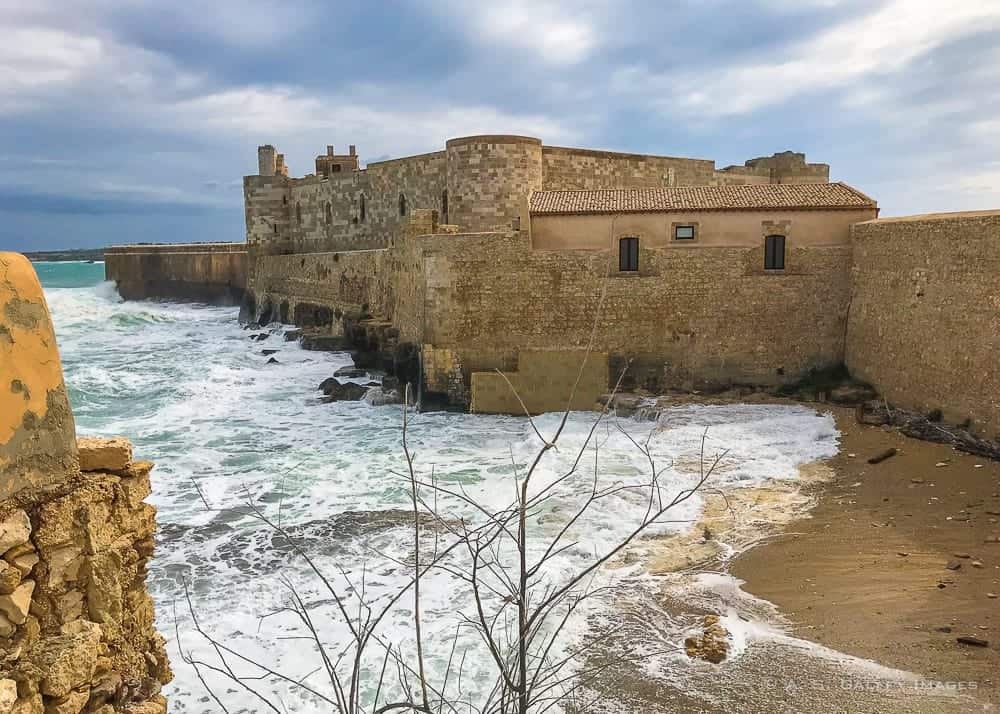
7. Church of Santa Lucia alla Badia
At the far end of the Piazza Duomo is the unassuming Church of Santa Lucia, the patron saint of Siracusa. The church houses one of Caravaggio’s most famous paintings, The Burial of Santa Lucia. Saint Lucia was martyred near this site in 304. Every year on December 13 there is a celebration in her name.
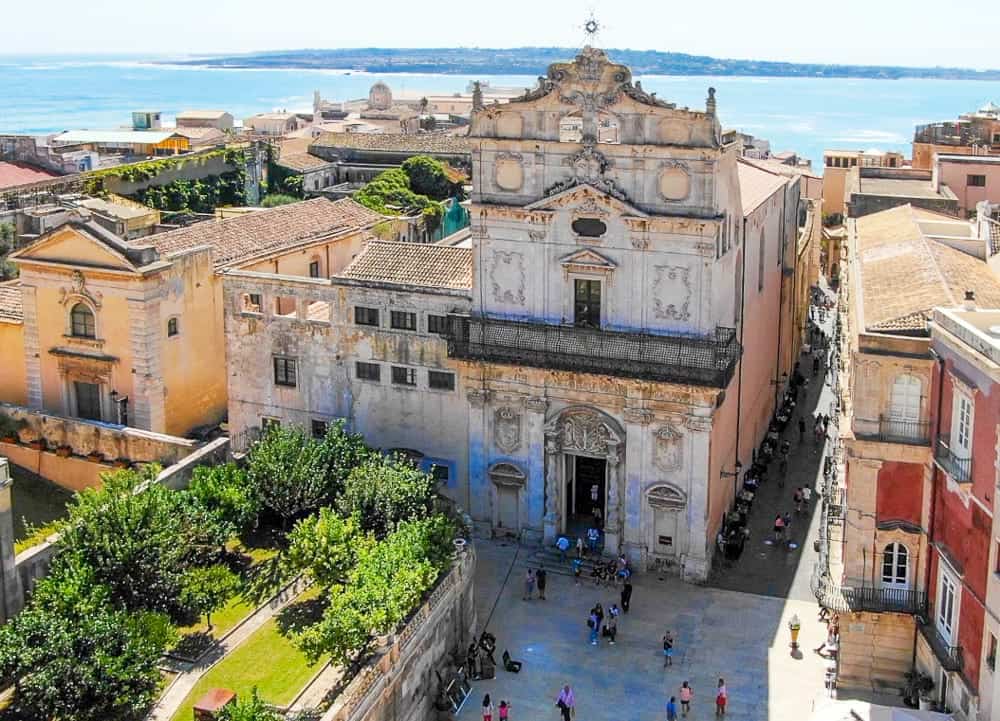

8. Opera dei Pupi (the Puppet Theater)
The puppet tradition is strong in many places in Sicily, and Ortigia is no exception. The puppet theater in Ortigia (Opera dei Pupi) opened its doors in the 19th century, at the initiative of the Vaccaro brothers. They used to present old medieval stories of chivalry and Italian poems of the Renaissance.
The family-run theater is quite alive and well today, continuing the tradition into the modern era. However, the puppeteers who manage both the theater and the nearby workshop, still make the puppets entirely by hand. Each “pupo” requires one month of work!
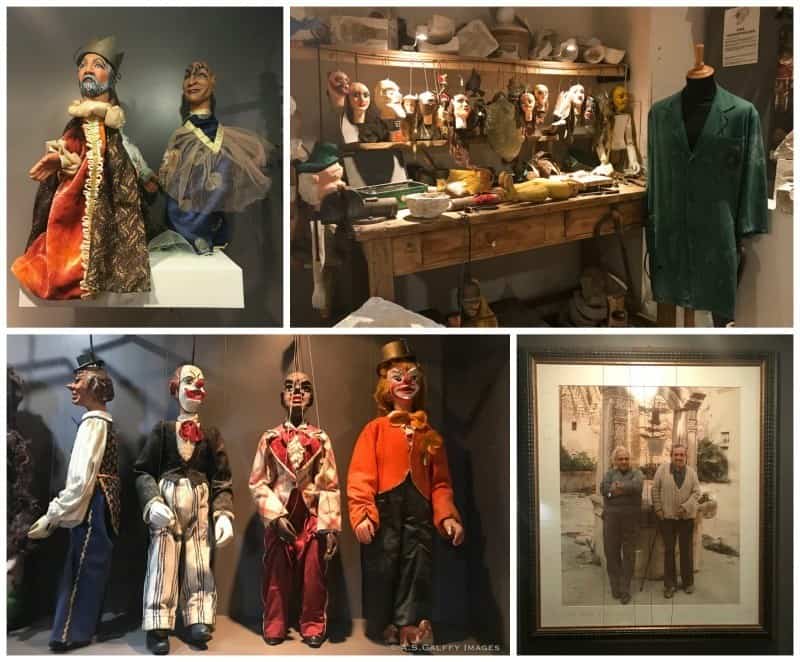
Opera dei Pupi offers performances every day at 5:00 p.m., so if you have time don’t hesitate to go in. Watching a puppet show is a cultural experience worth trying at least once. It was my most favorite thing to do in Ortigia. Buying tickets in advance is a good idea, as the theater is pretty small (it can only accommodate 30 people).
Adjacent to the theater it’s a small puppet museum that has a fascinating collection of props, posters, puppets, and woodworking tools. We visited the museum before attending the puppet show.
I was expecting to see some small marionettes, but to my surprise the puppets were quite big. Almost the size of a small child. This makes them remarkably effective when viewing a performance. The museum is quite beautiful, but no substitute for the show. So if you have time, you should do both.
READ NEXT: How to Spend 10 Days in Italy – Four Excellent Itinerary Ideas
What to Visit Outside Ortigia Island
Archeological Park in Siracusa
Unlike Ortigia Island which is full of medieval buildings with a lot of character, chick restaurants, and many attractions, Siracusa is just a working Sicilian town. Other than the Greek/Roman ruins in the Archeological Park, there is not much else to see in Siracusa.
However, for the history lovers, Siracusa’s Archeological Park of Neapolis (Parco Archeologico della Néapolis) is a must! Although not as impressive as the vestiges we visited on Greece itinerary, or the ones at the Valley of the Temples in Agrigento, the Archeological Park is still worth exploring.
Unfortunately, except for the Greek Theater, not many buildings are standing after almost 2,500 years. Therefore when looking at these remains today, it’s difficult to imagine what Siracusa must have looked like when 300,000 people inhabited it.
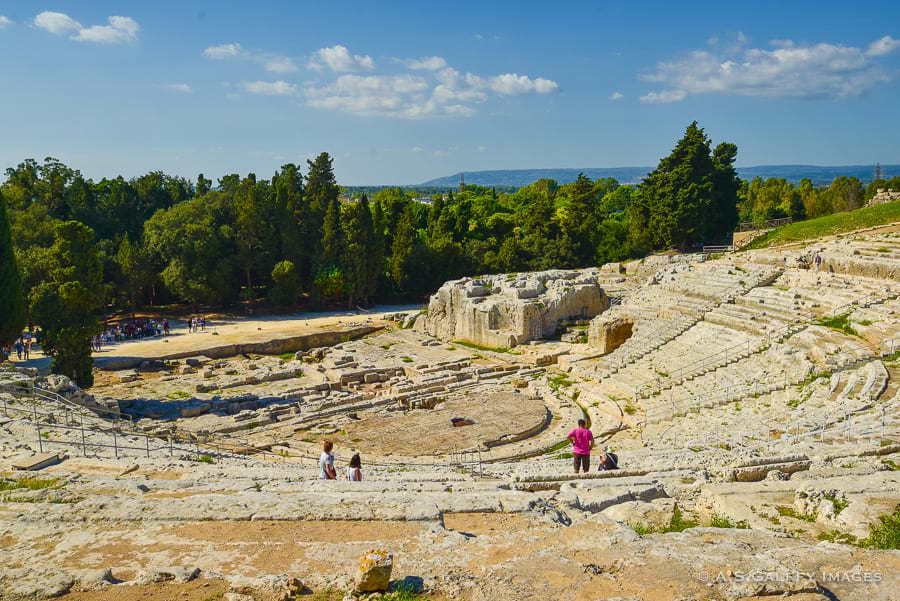
Archeological Remains in the Park
Besides the Greek Theater, which is bigger than the one in Taormina, there are some interesting remains of the the Altar of Hieron II (a grand altar for public sacrifices). Don’t miss the Street of Tombs, a series of cut deep into the bed-rock during the Hellenistic period. They say that one of these is the Tomb of Archimedes, the great mathematician, although many historians dispute this.
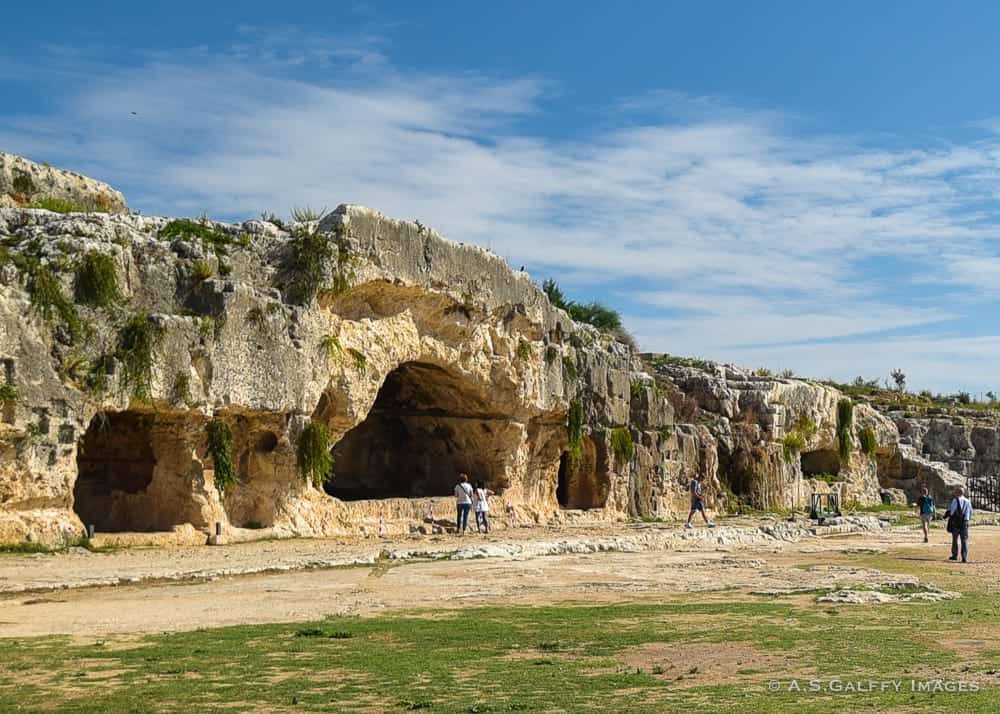
Don’t miss the artificial caves on the top of the Greek Theater. They used to supply water for the theater in its days of glory. The most impressive one is the Cave of the Nymph that has a vaulted ceiling and large pool inside.
Latomia del Paradiso
One of the great curiosities in the archeological park is the mysterious Latomia del Paradiso, a deep limestone quarry from the 6th century B.C. The quarry was used to extract stone for the ancient city.
The area is pierced with catacombs and filled with a lot of vegetation. It’s quite beautiful to walk through and discover the strange rock shapes left behind after the quarry was abandoned.
One of the most interesting formations in the quarry is the Ear of Dionysius (Orecchio di Dionisio). This is a huge 23m high grotto that extends 65m back into the cliffside. The grotto has some very unusual acoustic properties that amplify even the quietest of sounds, allowing them to be heard through an opening at the top.
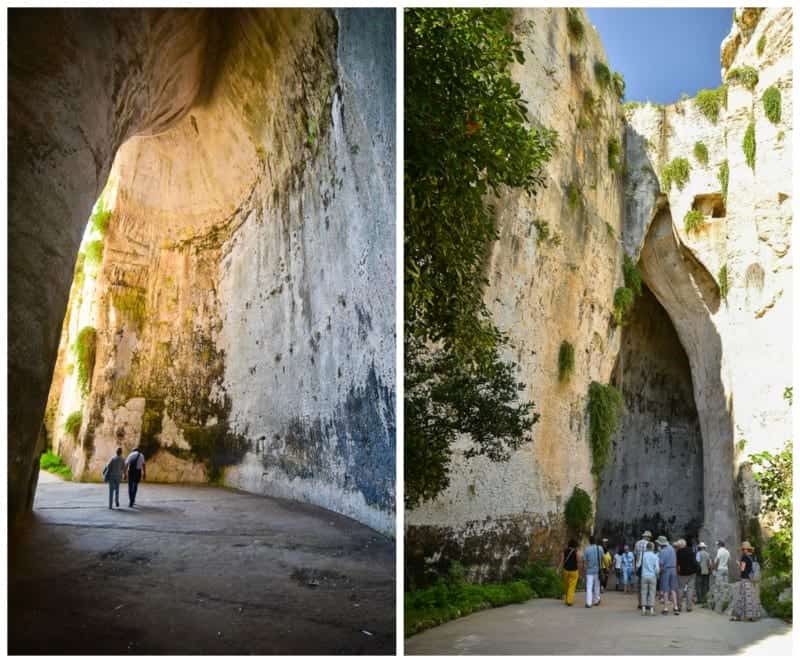
Italian painter Caravaggio named the cave after the Greek tyrant Dionysius. According to the legend, Dionysius who used the grotto as a prison, secretly listen from the top to the prisoner’s conversations.
Where to Stay When Visiting Siracusa and Ortigia Island
Compared to Taormina that is perched up on the mountain offering spectacular views, Siracusa is quite flat. Therefore, there is no point in looking for a room with a view. The next question is what should you choose as your base: Siracusa, or Ortigia Island?
If you come to Sicily by car, you should consider staying in Siracusa. Especially if you plan to do day trips around the city. Parking is Siracusa is not easy, but you can still find a spot or two, here and there.
By contrast on Ortigia Island parking is extremely difficult (if not impossible!) Also, the bridges connecting Ortigia to the mainland can sometimes be a bottleneck of traffic. Walking to Ortigia from Siracusa is a breeze. Or you may choose to hire a cab, which costs only a few Euros.
There are plenty of hotels and B&Bs to choose from, both in Siracusa and Ortigia island. We rented a modern and very well appointed room with a balcony through Airbnb.
It took us only 10 minutes to walk to Ortigia and 15 minutes to walk to the Archeological Park of Neapolis. If you prefer a hotel room, you can check out some prices on TripAdvisor or Expedia.
Where to Eat on Ortigia Island
Sicilian food is delicious and finding good eats both in Siracusa or on Ortigia island is not a problem. Most restaurants in this area serve traditional Italian food: pasta dishes, risotto and plenty of seafood.
There are of course the usual tourist traps where you’ll get mediocre food and bad service, especially in Ortigia. However, we stumbled upon a few excellent ones that are real worth mentioning: La Tavernetta da Piero, Ristorante Regina Lucia, and La Volpe e L’Uva. The last one is a lovely outdoor pizzeria that has the best location in town: right in front of the Cathedral of Siracusa, on the main square.

If you are looking for Sicilian food products, don’t miss the Ortigia market that is held every day of the week near the parking area of Talete. The market is colorful and lively and is open between 7am to 1pm every day, except for Sundays. The market sells almost everything, from cheeses to meat to wines and spirits and even expensive spices.
Did you find this article helpful? Pin it for later:
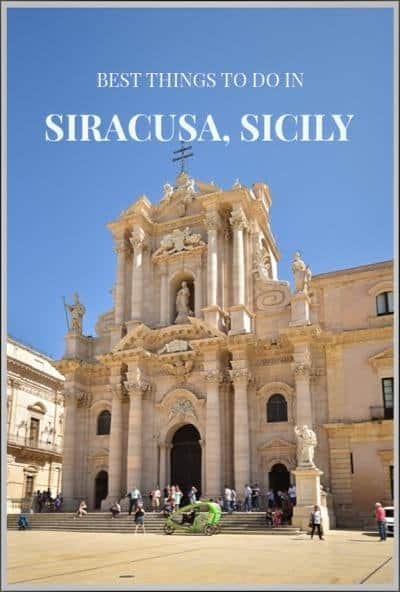

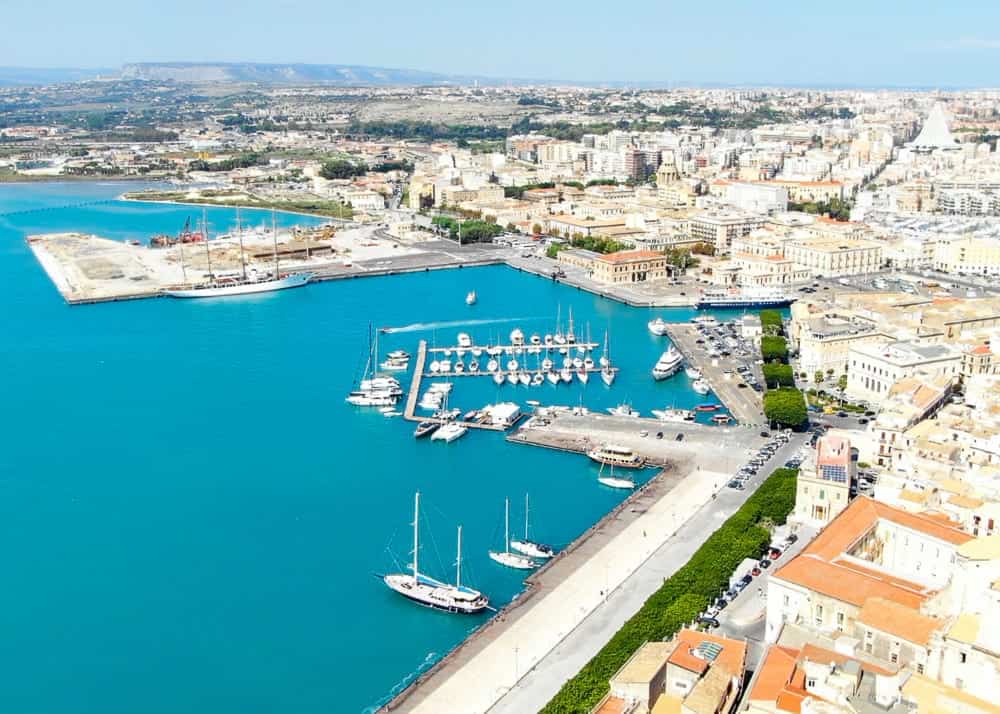
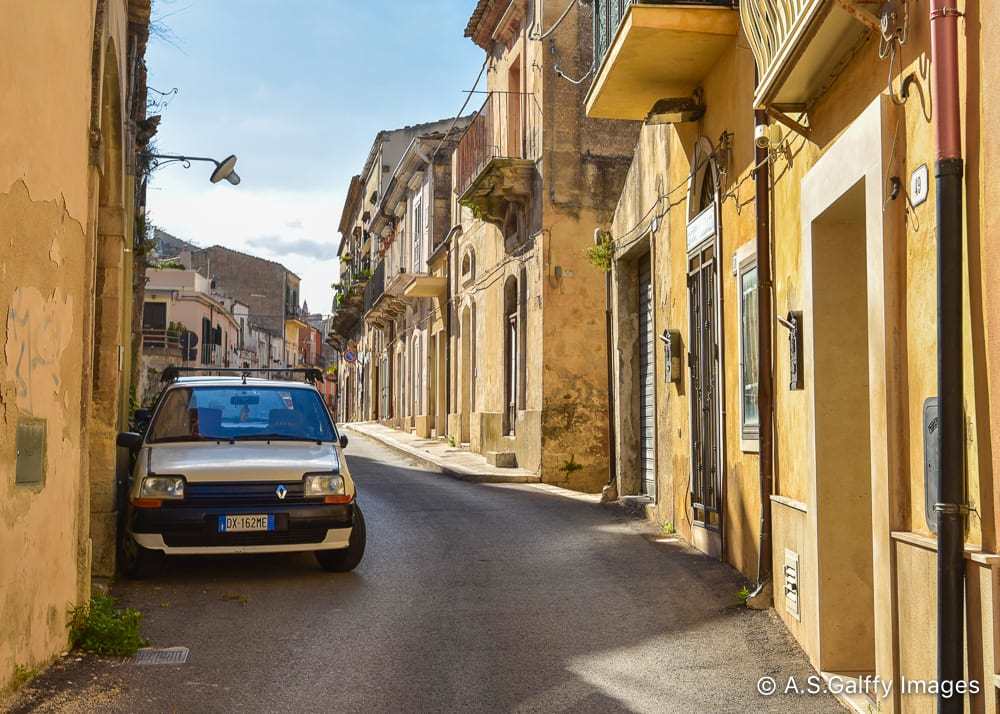 Driving in Sicily – The Thrills and Challenges of Visiting Sicily by Car
Driving in Sicily – The Thrills and Challenges of Visiting Sicily by Car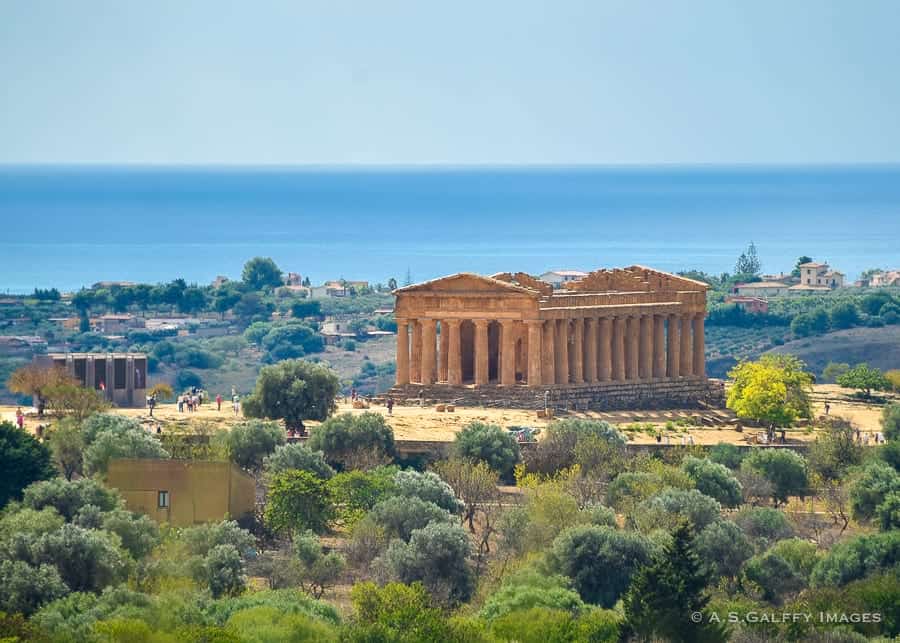



sally
Wonderful information for our family visit in June You do not mention the church of La Madonna delle Lacrime.
Any info on the church and distance from Ortigia? Walkable? We are a family of 20 adults and children. Any nearby towns worth visiting . Only have a couple of days and spending time with family in Floridia and Solarino. Thank you.
Anda
I have no information about that church, Sally. Sorry.
Rupert Downing
I stayed in Siricusa on Ortiega Island travelling by train and taxi. I found it a mixed experience. Beautiful historic setting, great small swimming spots. Terrible AirBNB. Some great restaurants, some terrible. Some very rude service, some acceptable. Evidence of a lot of mafia corruption. Lots of very rude and imperious neighbours who thought I didn’t understand their insults and seemed to own the whole street. I wouldn’t personally go back. Scratch the surface and you find something quite nasty, even in the Churches.
Anda
Sorry to hear you had a bad experience in Siracusa.
Jennie
Thank you for providing such a thorough travel guide. I’d love to visit Ortigia Island someday.
Connie Bonnici
Thank you And a for giving us such information about Ortigia. We’ll be visiting Syracuse and Ortigia next January and sure we’ll be finding your post so useful. One thing that you did not mention is the popular market that’s on every Sunday. Is it still happening pls and where is it? Thank you.
Anda Galffy
I’m glad you found the information useful, Connie. The market is located near the parking area of Talete and it opens from around 7:00 am-1:45 pm every day of the week, except for Sundays. By 2:00 pm it’s all over.
Bhushavali N
10 day Sicily itinerary? Whoa! I may never be able to do that. But I am hoping to visit Sicily soon. So I’ll take yours and squeeze and chop it for 3-4 days! Lolz…
Siracusa looks impeccable. You got me at the archaeological park. I loved anything that’s historical and I’ll surely add this to my list.
Neapolis is way too fascinating. I might spend a day here. The Mitveh and Maniace Castle are impressive too!
Clarice
I read a lot of good things about Ortigia Island and Siracusa and we’re actually planning to visit soon. Thus, I am so happy to see your post. It is very timely, detailed and helpful. Bookmarked it for future reference.
So excited to visit the Puppet theater.
Annick
This makes me want to visit Sicily! I usually see fishing villages which are fine but Siracusa really appeals to lovers of history. I’m amazed at how much remains from the Greeks and Romans. The architecture is magnificent. I’d love to watch one of the puppet shows. There is so much love put into building each one of them that I’d glad to see the tradition continues.
Sinjana Ghosh
Archeological park is such a fun idea of place. Museum is common, but an open park with samples from the history of earth is just outstanding. Your pictures from Sicily archeological park just stole my heart. Greek theatre looks awesome
Lisa
Aw I’m so happy you enjoyed Siracusa and Ortigia! We’re back in Sicily every summer, and it’s a city I know very well. I love the Teatro Greco and could happily spend a few hours there. I much prefer it to Taormina too, and the duomo never fails to impress!
Daniel
What an interesting and comprehensive article that comes at the right time! I was planning to visit Syracuse in February and you just made me so excited about the trip! I’m so glad I came across this article. Thank you for sharing and keep up the great work
Ann
What a lovely guide to Siracusa. Never been there myself but have been to Italy many times before, always wanted to explore Sicily further. You have some inspirational photos – I particularly loved the ones from the grotto. This would be an ideal destination for me to visit. Need to pin this post as I am planning to return to Italy this summer and would love some guides on what to see and do.
Kavita Favelle
I visited Sicily many decades ago, on a family holiday with my parents, and have been meaning to organise a return visit with my husband for the last 2 decades, at least! Your post on Siracuse is so helpful, especially in all the sightseeing suggestions for Ortigia, and also your tips for visiting the Archeological Park at Neapolis. I remember visiting these ruins on that long-ago trip, but we didn’t have a long stop there and I’d really love to explore the ruins and surrounding park area more fully. Have pinned to re-read ahead of planning a visit!
Anda Galffy
Thank you, Kavita. Hopefully you’ll manage to return to Sicily soon.
Amy Chung
What a wonderful post! I have to admit I don’t know very much about Syracuse at all and you took me on a such an amazing history lesson. I absolutely love meandering through narrow cobblestone laneways when you’re suddenly confronted with a massive piazza! I remember I had that same feeling in Venice. The deep limestone quarry looks imposing and sitting in the piazza all day would just be bliss.
Jane Dempster-Smith
Anda thanks for the article. Looks like we need to add Siracusa to our bucket list. There are definitely two things we would like to do – the December 13 celebration of Saint Lucia and the puppet theatre at 5pm. How can you book the tickets for the puppets?
Anda Galffy
You have to go buy the tickets at least a day ahead of time. I’m not sure they can be booked online.
Keri | Ladies What Travel
What a detailed, interesting guide! Love my history so this place really appeals…
Emese
I absolutely enjoyed this post, Anda! So much history, and such a beautiful city – or part of city , Ortigia Island. I would love to visit, and spend time at the archaeological park, as well. As usual, your images are gorgeaous, and I love all the history you added, putting it all in perspective.
Anda Galffy
I hope you will visit Sicily someday, Emese.
Rob+Ann @TravelLatte(.net)
What a beautiful and fascinating city! While I was aware of the Greek and Roman history, I didn’t know that the city had “changed hands” so many times. That certainly leads to an interesting culture, and it looks like Siracusa has preserved it well. Just reading through this, I feel like a week would not be enough to spend wandering its streets! Thanks for the great photos and inspiring details.
Anda Galffy
Sicily is quite a place to visit. Hope you’ll make it there someday.
Lyn aka The Travelling Lindfields
I think it is time to go back to Sicily. The only thing I remember about Siracusa is the ampitheatre in the archeological park – that was just fabulous. I will tuck your post away for a return visit.
Anda Galffy
I plan to return too, Lyn. Sicily can’t be seen in one single visit.
Rhonda Albom
Wow. There is an awful lot of history in Siracusa. I never realized that the name Syracuse was derivative from this island. I love the idea of meandering through the little island of Ortigia. The story about the hiding of the mikveh bath is interesting.
Anda Galffy
It’s surprising to see how recently the mikveh was discovered.
Anisa
Wow Siracusa is impressive and I hadn’t ever heard of it before. Some of the ruins remind me of ones I have seen in Greece. Castello Maniace right by the coast is just breathtaking.
Jill Chapman
A beautiful setting and beautiful photos. I admit that I know little about Sicily and even less about Siracusa but I still would love a visit.